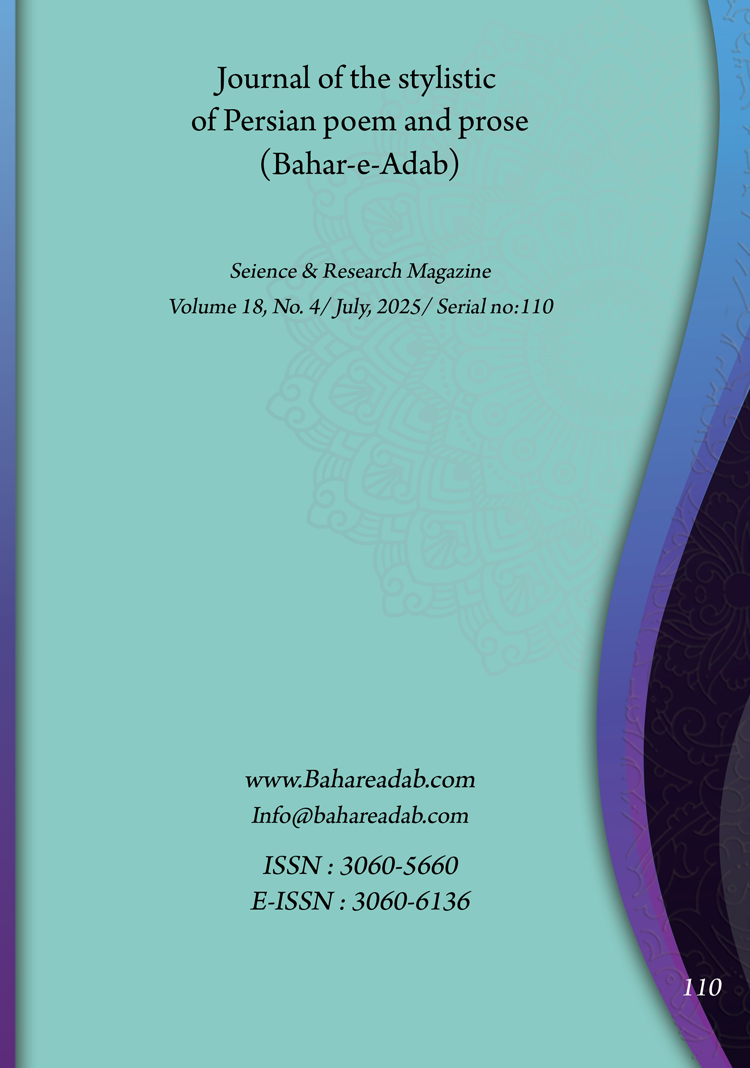- Count View : 79
- آدرس کوتاه شده مقاله: https://bahareadab.com/article_id/1847
- کد doi مقاله: Doi: 10.22034/bahareadab.2025 .18 .7863
Journal of the stylistic of Persian poem and prose
volume Number 18،
number In Volume 4،
،
issue Number 110
Features of Indian Style, School of Voghooe and Vasokht in Shani Taklu’s Divan
Mohammad Rahimi , Mohammad Amir Obaydinia (Author in Charge)
Abstract
BACKGROUND AND OBJECTIVES: One of the poets of Indian style during the period of Vajiya al-Din Nasaf Agha, nicknamed Shani Taklu, was in the mid-10th century and a contemporary of Shah Abbas Safavi. Although most of Shani’s poems are simple and in this respect he should be considered a follower of the School of Occurrence, many features of Indian style such as paradoxical images, sensuality, specific numerical dependencies, identification, specific combinations, abstraction, equational style, etc. are seen in his poems, which places his poetry on the border between the School of Voghooe and Indian style.
METHODOLOGY: This research seeks to answer this question: What are the characteristics of the Indian style, the school of Voghooe and vasukht in Shani Taklu"s Divan?
Study Method: This article is written in an analytical and descriptive manner, and after providing an introduction to Shani Taklu and stylistics, the most prominent characteristics of the Indian style, the school of Voghooe and vasukht in Shani"s poetry Divan are examined and analyzed.
FINDINGS: In the tenth and eleventh centuries and before the Indian style, the school of occurrence and vasukht emerged as an intermediate style and freed the ghazal from the dryness and monotony of the ninth century and adorned it with simplicity of speech and thought. It expressed the true feeling between the lover and the beloved.
CONCLUSION: Shani should be considered a follower of the school of occurrence. But along with the characteristics of the school of Voghooe and vasukht that are abundantly found in his divan and ghazals, one can also find signs of the characteristics of the Indian style in his divan. Although they are few in number compared to the frequency of the characteristics of the school of Voghooe and vasukht, their presence makes his divan also noteworthy from the perspective of the Indian style, among which we can mention the images of paradox, sensuality, special numerical dependencies, identification, special combinations, abstraction, equational style, etc., and this makes him one of the poets who are at the boundary between the school of Voghooe and the Indian style.
Keyword
10th century poetry
, Indian style
, school of Voghooe
, vasukht
, Shani Taklu.
- Ali Asmand Joonghani, Eshaghi, F. Z., & Masoumi, M. R. (1989). Escape from protest-critical literature and politics in the Indian style. Scientific Monthly of Stylistics of Persian Poetry and Prose (Bahar Adab), 16(7), 19–35.
- Bahar, M. T. (2006). Stylistics or history of the development of Persian prose (Vols. 1–3). Tehran: Amir Kabir Publications.
- Elwell-Sutton, L. P. (1976). The Persian metres. Cambridge University Press.
- Futohi Rood Moejani, M. (2019). Style and fire in poetry (The pioneer and the leader and fire are magnificent, not wild). Persian Literary Criticism Journal, 12(4), 45–67.
- Golchin Maani, A. (1995). School of occurrence in Persian poetry (1st ed.). Mashhad: Ferdowsi University of Mashhad Press.
- Langroodi, S. (1993). Indian style and Kaleem Kashani (Gorbid Shoor Janun). Tehran: Markaz Publishing House.
- Losensky, P. (1998). Welcoming Fighani: Imitation and poetic individuality in the Safavid-Mughal ghazal. Mazda Publishers.
- Moein, M. (1984). Dictionary (6th ed.). Tehran: Amir Kabir Publishing House.
- Moezani, A. M., & Zeighami, A. (2011). The influence of Baba Faghani on the poetic currents of the Safavid era. Journal of Mystical Literature Studies, 11(3), 23–42.
- Nasaf Agha, V. (2011). Divan Shani Taklu (Dr. A. B. Karimi, Ed.). Tehran: Association of Cultural Works and Honors.
- Ohadi Hosseini Daqqaqi Baliani Isfahani, T. M. (2016). Arafat al-Asheqin and Arsat al-Arifin (Vols. 1–7). Tehran: Written Literature Publishing Center.
- Pour Parisa, M. (2013). The school of occurrence and occurrence, a common style in the poems of the tenth century AH. Journal of Literary Studies, 25(1), 45–67.
- Razmjoo, T. (2011). A look at the school of occurrence and occurrence in the history of Iranian literature. Journal of Literary Studies, 5(2), 77–92.
- Schimmel, A. (1975). Mystical dimensions of Islam. University of North Carolina Press.
- Shafiei Kadkani, M. R. (1987). Poet of mirrors. Tehran: Agah Publications.
- Shafiei Kadkani, M. R. (2001). The influence of Indian poetics on Persian poetry: A comparative study. Journal of Persian Literature, 8(2), 115–130.
- Shamisa, S. (2014). Stylistics of poetry (6th ed.). Tehran: Mitra Publications.
- Safa, Z. (1989). History of Iranian literature (Vol. 5, 10th ed.). Tehran: Ferdowsi Publications.
- Taylor, J. H. P. (1989). The Persian poets: A literary history. Cambridge University Press.
- Thackston, W. M. (1987). The Indian influence on Persian classical poetic forms. Journal of Indo-Persian Studies, 4(1), 56–72.
- Yarshater, E. (1988). Persian poetry in the Safavid period. In Cambridge History of Iran, Volume 6: The Timurid and Safavid periods (pp. 973–1004). Cambridge University Press.
- Yarshater, E. (1994). Persian literary criticism: From the classical to the modern era. Persian Studies Journal, 32(3), 77–92.
- Zarrinkoob, A. (2014). A journey in Persian poetry (5th ed.). Tehran: Sokhan Publications.

